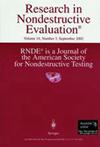涡流引起的磁化滞后及其对高速漏磁检测的影响
IF 1.6
4区 材料科学
Q3 MATERIALS SCIENCE, CHARACTERIZATION & TESTING
引用次数: 5
摘要
在高速漏磁检测中,被测工件快速通过充磁器。因此,工件磁化时间短。由于涡流效应,工件内部的磁场不能瞬间达到平衡,如果磁化时间不够,使磁场达到平衡,则会因磁化不完全而改变磁极信号。本文研究了涡流引起的磁化时滞及其对高速磁流变试验的影响。磁场在试件(包括钢筋和钢管)中达到平衡所需的时间是通过理论计算、有限元模拟和实验得到的。结果表明,样品内部磁场达到平衡所需的时间在50-100 ms之间。使用传统的充磁器,在10m /s的检测速度下,由于工件在内部磁场达到稳定状态之前到达检测区,缺陷信号发生了变化。一个简单的解决办法是增加磁化线圈的轴向长度。在此过程之后,以0.1 m/s和10m /s的速度获得的信号几乎相同。本文章由计算机程序翻译,如有差异,请以英文原文为准。
Magnetization Time Lag Caused by Eddy Currents and Its Influence on High-Speed Magnetic Flux Leakage Testing
ABSTRACT In high-speed magnetic flux leakage (MFL) testing, the tested workpieces pass rapidly through magnetizers. Thus, the magnetization time for workpieces is short. Because of the eddy current effect, the magnetic field inside the workpieces cannot instantly reach equilibrium, and if the magnetizing time is insufficient for the field to reach equilibrium, the MFL signals will be changed because of incomplete magnetization. In this article, the magnetization time lag caused by eddy currents and the influence of this lag on high-speed MFL testing is investigated. The time required for magnetic field to reach equilibrium in specimens, including steel bars and pipes, is obtained by theoretical calculations, finite element simulations, and experiments. The results indicate that the time required for a magnetic field inside a specimen to reach equilibrium is in the range of 50–100 ms. Using conventional magnetizers, the defect signals at testing speed of 10 m/s change because the workpiece reaches the detection zone before the magnetic field inside reaches the stable state. A simple solution is to increase the axial length of the magnetizing coil. After this procedure, signals obtained at 0.1 m/s and 10 m/s are almost identical.
求助全文
通过发布文献求助,成功后即可免费获取论文全文。
去求助
来源期刊

Research in Nondestructive Evaluation
工程技术-材料科学:表征与测试
CiteScore
2.30
自引率
0.00%
发文量
14
审稿时长
>12 weeks
期刊介绍:
Research in Nondestructive Evaluation® is the archival research journal of the American Society for Nondestructive Testing, Inc. RNDE® contains the results of original research in all areas of nondestructive evaluation (NDE). The journal covers experimental and theoretical investigations dealing with the scientific and engineering bases of NDE, its measurement and methodology, and a wide range of applications to materials and structures that relate to the entire life cycle, from manufacture to use and retirement.
Illustrative topics include advances in the underlying science of acoustic, thermal, electrical, magnetic, optical and ionizing radiation techniques and their applications to NDE problems. These problems include the nondestructive characterization of a wide variety of material properties and their degradation in service, nonintrusive sensors for monitoring manufacturing and materials processes, new techniques and combinations of techniques for detecting and characterizing hidden discontinuities and distributed damage in materials, standardization concepts and quantitative approaches for advanced NDE techniques, and long-term continuous monitoring of structures and assemblies. Of particular interest is research which elucidates how to evaluate the effects of imperfect material condition, as quantified by nondestructive measurement, on the functional performance.
 求助内容:
求助内容: 应助结果提醒方式:
应助结果提醒方式:


